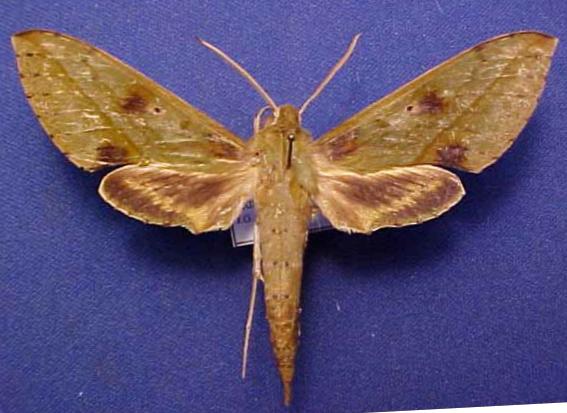Xylophanes ockendeni
Xylophanes ockendeni

Xylophanes ockendeni courtesy of John Vriesi.
This site has been created by
Bill Oehlke at oehlkew@islandtelecom.com
Comments, suggestions and/or additional information are welcomed by Bill.
TAXONOMY:
Family: Sphingidae, Latreille, 1802
Subfamily: Macroglossinae, Harris, 1839
Tribe: Macroglossini, Harris, 1839
Genus: Xylophanes Hubner [1819] ...........
Species: ockendeni Rothschild, 1904
|
MIDI MUSIC
.....It's a Wonderful World.....
copyright C. Odenkirk
ON.OFF
<bgsound src="world.mid" LOOP=FOREVER>
|
DISTRIBUTION:
Xylophanes ockendeni (wingspan: males: 69-77mm; females: probalby larger) flies in
Peru: (specimen type locality) Junin, Puno.
Xylophanes ockendi is similar to Xylophanes rothschildi, but ockendi is distinguished by the slightly scalloped forewing
outer marging; the more well-defined forewing dark basal patch; the transversely (not longitudinally) oriented dark patch distal to the discal spot; and
the sinuate, brown postmedian band, distal of which, on the inner margin, is a black, triangular patch.The abdomen has
a thin, brown dorsal line, on either side of which is a row of small black spots, one on the posterior edge of each tergite.
The underside of the abdomen has a lavender-red coloration.
This species has a forewing upperside most similar to Xylophanes macasensis, but the ground colour of ockedni is a deeper, darker, more bluish-green,
on which the darker markings are less prominent, making the whole moth look more drab. The postmedian line is brownish, sinuate, less conspicuous and more poorly
defined, distally blending in with the ground colour. The area around the discal spot is paler than in Xylophanes macasensis, rendering the spot more
conspicuous. The submarginal line is represented by a series of small, dark vein spots. CATE
Xylophanes ockendeni sensu Eitschberger, flies in Cusco, Peru.
FLIGHT TIMES:
Xylophanes ockendeni adults fly????
ECLOSION:
Pupae probably wiggle to surface from subterranean chambers just prior to eclosion.
SCENTING AND MATING:Females call in the males with a pheromone released from a gland at the tip of the
abdomen. Males come in to lights very readily, but females are seldom taken in that way.
EGGS, LARVAE, PUPAE:
Larvae probably feed on
members of the Rubiaceae or Malvaceae families.
Moths emerge approximately one-two months after larvae pupate.
Use your browser "Back" button to return to the previous page.
Goto Main Sphingidae Index
Goto Macroglossini Tribe
Goto Central American Indices
Goto Carribean Islands
Goto South American Indices
Goto U.S.A. tables
